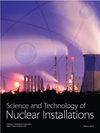利用CINEMA模拟TMI-2严重事故堆芯损伤过程
IF 0.9
4区 工程技术
Q3 NUCLEAR SCIENCE & TECHNOLOGY
引用次数: 0
摘要
CINEMA作为韩国国内用于严重事故序列分析的综合计算机代码开发,经历了从启动事件到遏制失败的发展历程。CINEMA计算机代码由CSPACE、SACAP和SIRIUS组成,它们能够分别通过RCS(反应堆冷却剂系统)的热工分析、安全壳的严重事故分析以及安全壳和安全壳中的裂变产物分析来模拟堆芯熔化过程。作为CINEMA计算机代码验证的一部分,分析了TMI 2单元的严重事故进展。进行该分析是为了验证关于堆芯熔体过程的CINEMA模型,特别是在堆芯熔体过程中的RCS热水力行为、燃料包层氧化产生氢以及燃料熔化转移到堆芯下部。并将CINEMA在RCS压力和综合产氢质量等主要参数上的结果与TMI-2数据进行了比较。CINEMA结果表明,RCS压力与TMI-2数据非常相似。CINEMA的结果和测量的总产氢量非常相似,分别约为465千克和460千克。本文章由计算机程序翻译,如有差异,请以英文原文为准。
Simulations of Core Damage Progression for TMI-2 Severe Accident Using CINEMA Computer Code
As an integrated computer code development for severe accident sequence analysis in Korea, CINEMA has been developing from an initiation event to a containment failure. The CINEMA computer code is composed of CSPACE, SACAP, and SIRIUS, which are capable of simulating core melt progression with thermal hydraulic analysis of the RCS (reactor coolant system), severe accident analysis of the containment, and fission product analysis in the vessel and the containment, respectively. The severe accident progression in TMI unit 2 has been analyzed as a part of a validation of the CINEMA computer code. This analysis has been performed to validate CINEMA models on the core melt progression, in particular, RCS thermal hydraulic behavior during core melt progression, fuel cladding oxidation with hydrogen generation, and fuel melting with relocation to the lower part of the core. The CINEMA results on main parameters, such as RCS pressure and an integrated hydrogen generation mass are compared with the TMI-2 data. The CINEMA results have shown that the RCS pressure is very similar to the TMI-2 data. The CINEMA results and measured total hydrogen production are very similar, which were approximately 465 kg and 460 kg, respectively.
求助全文
通过发布文献求助,成功后即可免费获取论文全文。
去求助
来源期刊

Science and Technology of Nuclear Installations
NUCLEAR SCIENCE & TECHNOLOGY-
CiteScore
2.30
自引率
9.10%
发文量
51
审稿时长
4-8 weeks
期刊介绍:
Science and Technology of Nuclear Installations is an international scientific journal that aims to make available knowledge on issues related to the nuclear industry and to promote development in the area of nuclear sciences and technologies. The endeavor associated with the establishment and the growth of the journal is expected to lend support to the renaissance of nuclear technology in the world and especially in those countries where nuclear programs have not yet been developed.
 求助内容:
求助内容: 应助结果提醒方式:
应助结果提醒方式:


